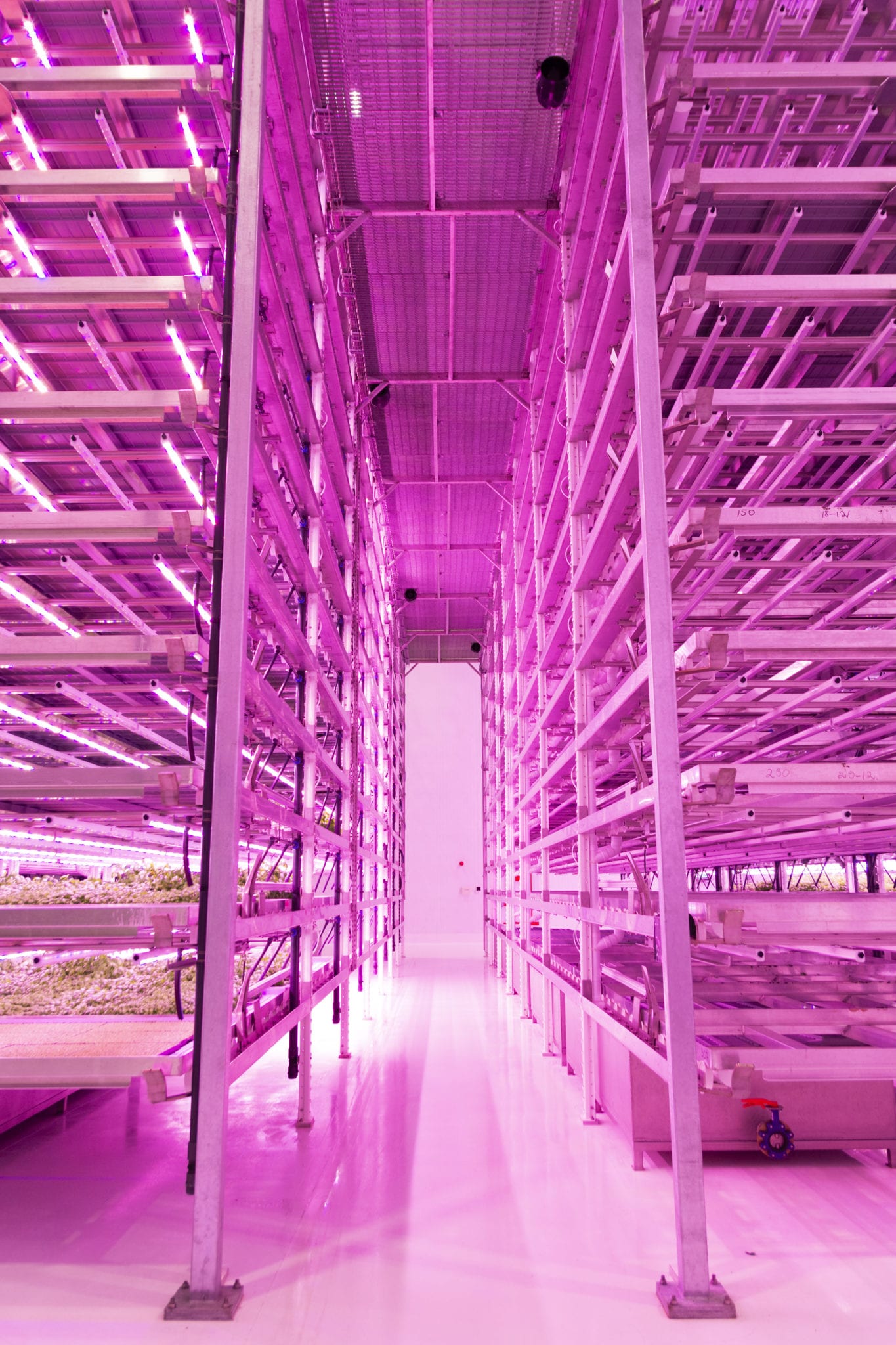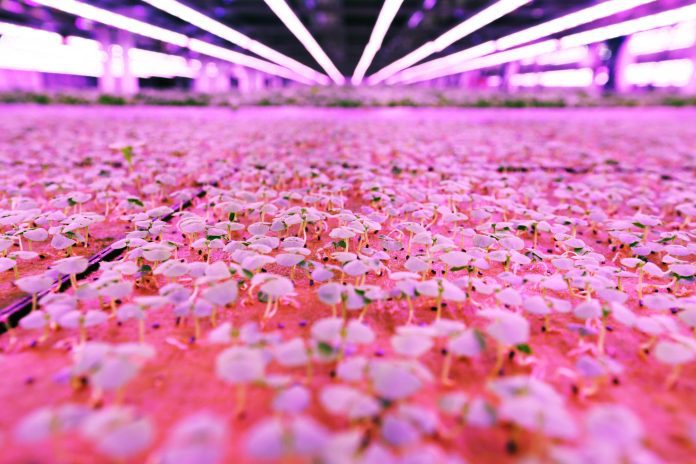The vertical farming industry in its infancy, with most practitioners stuck in hobbyist production. But the fragile case for growing food in warehouses – automated and dynamic local production, using less water, less fertiliser, less energy – is alive and kicking, in the British countryside.
Jones Food Company runs one of the largest indoor farms in the world. The business has gone from a scrawled blueprint of an idea to full-scale production in just two years, with smart lighting as the central infrastructure platform for its innovation.
“The lighting is intrinsic to the whole system; it represents the highest capital cost, and it has to be set just right,” says James Lloyd-Jones, the company’s founder and chief executive. The company has invested over £1 million on 12 kilometres of indoor ‘balance’ lighting.
It is able to give each plant its own private dosage of light to ensure uniform growth in intensive conditions. The company will, in short order, be hitting production capacity: 420 tonnes of leafy greens per year (the weight of 70 elephants), enough to fill 11 million sandwiches a week.

In March 2018, the company had just started work to clear an old cold store in the Lincolnshire countryside. At the time, Lloyd-Jones was just starting through a black-book of new business ideas. He had quit school at 16, and the RAF within days of joining, and had been searching around, with stints at solar farms, estate agents, and mobile climbing walls.
Vertical farming was only the first on his list (“one of seven good ideas,” he says) to pan out. And how. The Lincolnshire facility is now stacked to the rafters with growing trays and awash with artificial light. It measures 5,120 square metres – the equivalent of 26 tennis courts.
But that is just a horizontal measure; the growing space is multiplied upwards, to a height of 11 metres. The lighting network snakes through all its levels. By October 2018, the firm was harvesting its first crop; a month later, it was serving local demand for natural ingredients, notably with convenience-store food brand Greencore, but also for pharmaceutical and cosmetic products.
A year ago, Ocado Technology, the innovation arm of food retailer Ocado, ploughed £17 million into the business, in return for a 68 per cent stake; it wants to tap into the firm’s expertise, and recreate its setup. A deal with its retail division is about to go live, says Lloyd-Jones.
For indoor farming, lighting is everything; the big challenge and great opportunity is to replace natural light with a highly-controlled artificial light spectrum, which can be tweaked in response to growing requirements. Jones Food Company recruited GE Current – since acquired by private equity firm American Industrial Partners (AIP) – to install the infrastructure, and help fine-tune the controls.
A higher proportion of red wavelengths have been engineered for reproductive growth, to promote leaf coverage and fruit generation; more blue is used for vegetative growth, for plant structure and leaf mass; a finer mix of red, blue and white brings balanced growth, for overall performance.
Lloyd-Jones is a fan of GE Current, and he has shopped around. “For us, GE [Current] has the most efficient light on the market; it is just bad at telling people about it,” he says. For the record, he is happy to compare, as well. “Signify is a fantastic marketing company, but its fixtures are metal bodied, and hard to clean.”
He goes on: “OSRAM, all these guys – they’re okay. But you have to look at the commercial package. GE offers a five-year warranty, compared with three years from the rest. And the L90 score, after five years, is way better. We are buying a better light, at the end of the day – one that is easier to clean, and comes with a longer warranty.”
To explain; the Arize lighting system from GE Current is IP66 wet-rated, so it can be cleaned and sanitised in situ. It keeps the growing area free of pathogens, and also means crops can be grown without pesticides and with half the fertiliser. Its L90 score, which measures how long a bulb sustains output power at 90 per cent or above, is 36,000 hours, which Lloyd-Jones rates highly.

The other technical draw for Jones Food Company is the energy savings from the Arize luminaires, which GE Current puts at 33 per cent. Lloyd-Jones calls the Lincolnshire facility a “power factory”. The savings are not just from the LEDs, versus traditional lighting, but from the lighting controls, to make sure light is being used properly.
“That’s where you get huge efficiencies – knowing if the lights are on at the wrong time, or if their position is awry,” says Lloyd-Jones. They generate less heat than other solutions, resulting in lower demand for cooling “than other vertical farms,” according to GE Current.
The facility is recycling water, and pumping in pure CO2, to reduce fresh air, help the plants ‘breathe’, and turbo-charge production. Thirty per cent of its power is served by renewable sources, mostly from its own solar panels; the firm is “bringing in new technology” to cover the rest, and will be carbon neutral by the end of the year, it says.
The partnership with GE Current has been good, says Lloyd-Jones. “Plenty of companies will sell you lights, and then forget about how you put those lights in, how close they are to the crops, where the racking goes. They won’t guarantee the lights. Ultimately, the lighting hardware is just one part of a bigger picture.”
Jones Food Company has painted most of the picture by itself, in fact. While lighting is everything, the fixtures, themselves, are only a conduit for the real innovation; a two-way prism for an explosion of data analytics, setting in motion a rush of software triggers and hardware controls to enable a sophisticated indoor growing system.
The lighting has to work, and make commercial sense, but the real magic happens either side. “You need the data to make sure everything is optimized,” says Lloyd-Jones.
Jones Food Company has developed its own technology platform, using UK engineering talent (again, “no one talks about it,” he says), which places lighting at the edge and data at the heart. “Twenty per cent is about the data points and control system; 30 per cent is the software we’ve developed to work out flows; the rest is hard engineering,” he says.
He makes clear this innovation, around set-points on one hand and “hard engineering” on the other, is separate of the lighting supply and management from GE Current. “They have been involved in none of the technology,” he says. “It is stuff we have built internally.”
The company has 36 patents pending, says Lloyd-Jones, with another couple to go in, and one already in the public domain (“waiting to be granted”). More than just making a good fist of vertical farming, it is this innovation that has turned heads at Ocado Technology, and forced the arrangement with GE Current into a partnership.
“We are one of only a handful of companies in the world that grow and sell produce using technology we have designed, developed, and built ourselves – which is tested and stressed day-in and day-out. We have real-world data, rather than science data in a container. It brings tremendous value, compared with someone selling a solution that has never been tested.”
The firm is consulting, sometimes even with GE Current, on the finer points of the interplay between smart lighting and smart production. “We’ve really enjoyed working with GE, and the relationship continues – to the point it recommends customers in vertical farming to us, to hold their hands, and see how to do things,” says Lloyd-Jones.
It is offering its own system into the bargain, as well – except it is not actually selling; it would rather offer closer interest for a bigger piece of the action. “We don’t sell the technology, as such; we do joint ventures with it. I could sell you a car, but who’s to blame if the car crashes? It is better that we drive it together. That way, both parties have skin in the game.”
So, is Jones Food Company a tech company or a farming company? It is a cross-breed, says Lloyd-Jones. “If you want to sound exciting, we are a tech company. But we’re really just farmers using different machinery to everyone else. And because we farm, the technology is proven.”

